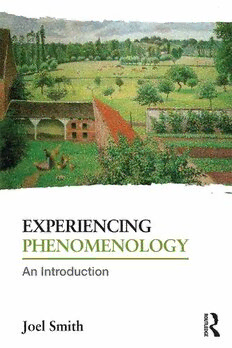Table Of ContentExperiencing Phenomenology
Phenomenology is the general study of the structure of experience, from thought and
perception,toself-consciousness,bodilyawareness,andemotion.Itisbothafundamental
areaofphilosophyandamajormethodologicalapproachwithinthehumansciences.
Experiencing Phenomenology is an outstanding introduction to phenomenology.
Approaching fundamental phenomenological questions from a critical, systematic
perspectivewhilstpayingcarefulattentiontoclassicphenomenologicaltexts,thebook
possessesaclarityandbreadththatwillbewelcomedbystudentscomingtothesubject
forthefirsttime.
Accessibly written, each chapter relates classic phenomenological discussions to
contemporaryissuesanddebatesinphilosophy.Thefollowingkeytopicsareintroduced
andexplained:
(cid:1) themethodologicalfoundationsofphenomenology
(cid:1) intentionalityasthe‘markofthemental’andtheproblem ofnon-existentobjects
(cid:1) perceptual experience,including ourawarenessofthings,properties,andevents
(cid:1) theexperience of body,self,andothers
(cid:1) imaginativeandemotional experience
(cid:1) detaileddiscussions ofclassicalphenomenologicaltexts,including:
(cid:1) Brentano’sPsychologyfromanEmpirical Standpoint
(cid:1) Husserl’s Logical Investigations, Cartesian Meditations, and On the Phenomen-
ologyoftheConsciousnessofInternalTime
(cid:1) Heidegger’sHistoryoftheConceptof Time,andBeingandTime
(cid:1) Stein’sOntheProblemofEmpathy
(cid:1) Sartre’s Transcendence of the Ego, Sketch for a Theory of the Emotions, and
TheImaginary
(cid:1) Merleau-Ponty’sPhenomenologyof Perception.
Also included is a glossary of key terms and suggestions for further reading, making
this book an ideal starting point for anyone new to the studyof phenomenology, not
onlyinPhilosophybutinrelateddisciplines suchasPsychologyandSociology.
JoelSmithisLecturerinPhilosophyattheUniversityofManchester,UK.
This page intentionally left blank
Experiencing
Phenomenology
An Introduction
Joel Smith
Add Add Add
AddAddAdd
Add
AddAdd AdAddd
Firstpublished 2016
byRoutledge
2ParkSquare, MiltonPark,Abingdon, OxonOX144RN
andbyRoutledge
711ThirdAvenue,NewYork,NY10017
Routledge isanimprint oftheTaylor &FrancisGroup,aninformabusiness
©2016JoelSmith
TherightofJoelSmithtobeidentifiedastheauthorofthisworkhasbeenassertedbyhim
inaccordancewithsections77and78oftheCopyright,Designsand PatentsAct1988.
Allrightsreserved.Nopartofthisbookmaybereprintedorreproducedorutilizedinany
formorbyanyelectronic,mechanical,orothermeans,nowknownorhereafterinvented,
including photocopyingandrecording, orinanyinformationstorage orretrievalsystem,
withoutpermission inwriting fromthepublishers.
Trademarknotice: Productorcorporatenames maybetrademarks orregistered
trademarks,andareusedonlyforidentificationandexplanationwithoutintenttoinfringe.
British LibraryCataloguing inPublication Data
Acataloguerecordfor thisbookisavailablefromtheBritishLibrary
LibraryofCongress Cataloging inPublication Data
Names:Smith,JoelAlexander.
Title:Experiencing phenomenology:anintroduction/ byJoelSmith.
Description: 1[edition].|NewYork:Routledge, 2016.|Includesbibliographical
referencesandindex.
Identifiers:LCCN2015039169|ISBN9780415718929(hardback:alk.paper) |
ISBN9780415718936(pbk.:alk.paper)|ISBN9781315628639(e-book)
Subjects: LCSH:Phenomenology.
Classification:LCCB829.5 .S5342016|DDC142/.7–dc23
LCrecordavailable athttp://lccn.loc.gov/2015039169
ISBN:978-0-415-71892-9 (hbk)
ISBN:978-0-415-71893-6 (pbk)
ISBN:978-1-315-62863-9 (ebk)
Typeset inTimesNewRoman
byTaylor&FrancisBooks
For Ann, Ivy, Sylvia, and Karina
The first elaboration of the field of experience, its phenomena and its givens
will offer us an ample supply of difficult and deep problems
Husserl, Thing and Space
Theterm‘phenomenology’expressesamaximthatcanbeformulated:‘Tothe
things themselves!’
Heidegger, Being and Time
Contents
List of figures xii
Preface xiii
1 The science of experience 1
1 Introducing phenomenology 2
1.1 What phenomenology is not 2
1.2 How phenomenological questions arise 4
1.3 The Phenomenological tradition 6
2 The science of experience 9
2.1 The phenomenological reduction 10
2.2 The phenomenological reduction on trial 13
2.3 The eidetic reduction 17
2.4 The eidetic reduction on trial 19
3 Back to the things themselves! 21
3.1 Husserlian phenomenology 21
3.2 Heideggerian phenomenology 24
4 Conclusion 29
2 The objects of experience 30
1 Intentionality in the Phenomenological tradition 30
2 The mark of the mental 31
3 The structure of intentionality 34
3.1 Intentional objects 35
3.2 Quality and matter 41
3.3 Noesis and noema 43
3.4 Sensation 44
4 Being-in-the-world 45
5 Conclusion 49
viii Contents
3 Experiencing things 50
1 The case for sense-data 51
1.1 Perspectival variation 51
1.2 Illusion 52
1.3 Hallucination 53
2 Perceptual experience as intentional 54
3 Bodily presence 56
3.1 Bodily presence and empty intending 56
3.2 Intuitive fulfilment and co-presence 57
3.3 Bodily presence and sensation 59
3.4 Bodily presence and non-conceptual content 63
4 Conclusion 66
4 Experiencing properties 67
1 Perceptual constancy 67
1.1 The experience of shape, size, and colour 67
1.2 Scepticism about perceptual constancy 68
1.3 Constancy and memory 74
2 Husserl on perceptual constancy 76
2.1 Constancy and adumbration 76
2.2 Intuitive fulfilment, co-presence, inner horizon, and
anticipation 77
2.3 Husserl and ‘intellectualism’ 78
3 Merleau-Ponty on perceptual constancy 80
3.1 The experiential context 81
3.2 The constancy of shape and size 82
3.3 The constancy of colour 86
4 Conclusion 88
5 Experiencing events 90
1 Events in experience 90
1.1 A puzzle about the experience of events 91
1.2 Succession and unity 92
1.3 The specious present 93
2 Husserl on time-consciousness 96
2.1 Primal impression, retention, protention 96
2.2 The temporal horizon 97
2.3 Retention and memory 99
3 Is Husserl’s account tenable? 101
3.1 Simultaneity 102
Contents ix
3.2 Repetition 103
3.3 Non-existence 103
3.4 Concurrence 103
3.5 Immediacy 105
4 Conclusion 106
6 Experiencing possibilities 107
1 Sensory imagination 107
1.1 ‘Mental images’ 107
1.2 Sensory and suppositional imagination 108
1.3 Sensory imagination and possibility 108
2 Sensory imagination as reproduced perception 109
2.1 Humean impressions and ideas 109
2.2 Imaginary objects: ‘the illusion of immanence’ 110
2.3 Imaginary experience: quasi-observation, positing, and
spontaneity 112
3 Sensory imagination as seeing-in 117
3.1 Experiencing pictures 118
3.2 Experiencing the imaginary 119
3.3 Is there a mental analogon? 121
3.4 Is there a need for a mental analogon? 122
4 Conclusion 124
7 Experiencing oneself 125
1 Self-awareness 125
1.1 Hume vs. Kant 125
1.2 Husserl vs. Husserl 127
2 Sartre against the transcendental ego 130
2.1 The unity of experience 131
2.2 The individuality of experience 133
2.3 Selfless experience 134
2.4 Transparency and the death of consciousness 136
3 Unreflected, reflected, and reflecting experience 138
3.1 Non-positional consciousness of consciousness 139
3.2 Reflecting and reflected consciousness 141
4 Conclusion 144
8 Experiencing embodiment 145
1 Körper and Leib 145
2 The sense of ownership 147

